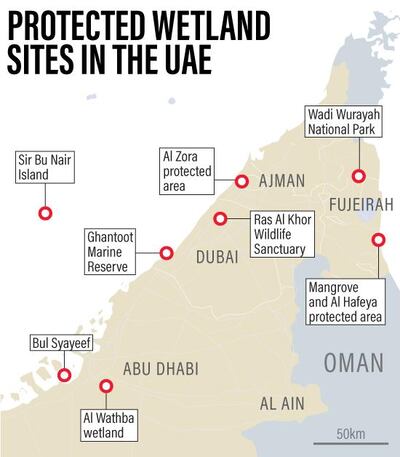More than 1,000 scientists and policymakers are meeting in Dubai to map out the future of the world's wetlands, after a sobering report showed more than a third of them have been destroyed since 1970.
The 170 signatories to the Ramsar Convention meet every three years to assess the state of wetlands.
This year's meeting follows the release of the first Global Wetland Outlook, a comprehensive look at global wetlands health.
“The hope is that the report will inform discussions here this week and be taken by up the local governments, the local policymakers and individuals when they go back home,” said Royal Gardner, a professor of law at Stetson University in Florida and one of the lead authors of the report.
“Hopefully they will use this report to take action with meaningful improvement on the ground.”
The report’s findings are bleak. It notes that 35 per cent of the world’s wetlands were destroyed between 1970 and 2015. They are at risk from industrial and agricultural pollution, urbanisation, rising water salinity, invasive species and changes to the marine environment that disrupt water flow and drainage. One in four species of wetland plants and animals are at risk of extinction.
Wetlands are crucial for global food security and the mitigation of climate change, yet their importance is often underestimated by world leaders and decision-makers.
The report gives a number of response actions, such as government integration of wetland conservation and restoration into climate change management strategies.
The United Arab Emirates has eight Ramsar sites covering a total of 369.8 square kilometres.
This week, the UAE delegation hopes to broaden the definition of what is classified as a wetland. It wants to add new categories, including arid wadis and sabkha salt flats.
"Wetlands in this region are not like any other wetlands," Hiba Al Shehhi, acting director of biodiversity at the Ministry of Climate Change and Environment, told The National. "Wetlands in this region have adapted. We want to highlight these areas and have them included in Ramsar because they are wetlands with a high international importance."
Seemingly devoid of colour, shape and life, sabkha salt flats are not what most people imagine when they hear the word wetland.
Yet coastal sabkhas experience periodic flooding and are home to algae and micro-organisms that make them a powerful carbon sink.
Arid wadis may not experience rainfall for years, yet when it rains they transform into lush sanctuaries for fish, reptiles and amphibians.
Having these environments recognised would help protect landscapes that have a less obvious value.
"When people imagine wetlands they imagine them to be wet all year long but that's not necessarily the case," Ms Al Shehhi said.
Of the world’s 12.1 million square kilometres of wetlands, about half are permanently inundated.
_______________
Read more:
A fifth of Abu Dhabi's mangroves in moderate or poor health, study shows
New strategy to be developed to protect UAE wetlands
_______________
The UAE will also propose that Arabic be included as an official language in the Ramsar Convention, and work with other countries in the region to establish or develop Ramsar sites.
Over the week, delegates will discuss topics ranging from rice paddy management to the future of peatlands, which occupy 3 per cent of land surface and store twice as much carbon as all the world’s forests.
Mbarga Alega Celestin, an agricultural engineer from Cameroon, came to Dubai on behalf of residents on the Nyong, a 690km river fed by the rainforest that flows to the Gulf of Guinea. The river is a lifeline for the 4.6 million inhabitants but it has narrowed so much in some areas that it has become impassable in places for their pirogue canoes.
Mr Celestin had come in hope of advice and support. “I want to explain the problem and see if there are experiences from other regions that can help us. The people around the Nyong live from it – for water, for food, for fishing, even for communication. There are no roads in some places, only the pirogues. It’s how they take their goods to market. The river is our hope.”
Each party has come with its own concerns and goals that illustrate just how connected the world's wetlands are.
"You can see wetlands are drying out around the world," said Abolfazl Abesht, the director of the Conservation of Iranian Wetlands Project.
"They are the richest ecosystem in the world in terms of biodiversity. Unfortunately, because of agricultural activities, water extraction and the construction of dams in basins, we are losing wetlands all around the world.
"And if we lose wetlands, it means we are going to lose a high amount of biodiversity all round the world."


